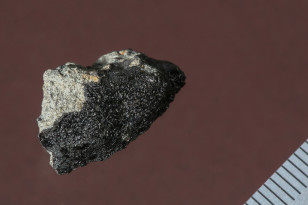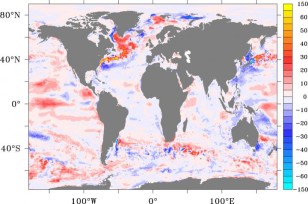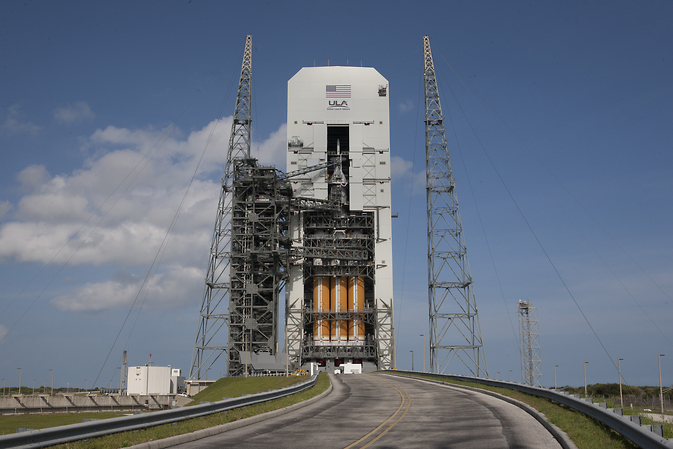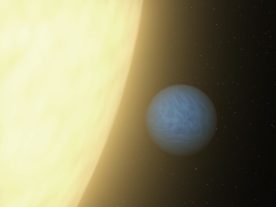
The Orion and Delta IV Heavy rocket stacked for launch at Space Launch Complex 37 at Cape Canaveral Air Force Station in Florida. (NASA/Kim Shiflett)
NASA Readies Orion Spacecraft for Test Flight
Excitement continues to build in Florida as NASA makes final preparations for the tomorrow’s (12/4/14) first unmanned flight test of Orion spacecraft, which the space agency plans to use to send astronauts to an asteroid and then to Mars.
Liftoff has been set for 1105 UTC from Space Launch Complex 37 at Cape Canaveral Air Force Station (CCAFS). The Orion will be sent into space atop a United Launch Alliance Delta IV Heavy rocket.
The spacecraft’s trip is scheduled to last about 4½ hours when it is expected to orbit the Earth twice and fly to an altitude of approximately 5,800 km.
NASA said that Orion’s test flight was designed to assess many of the mechanisms that would pose the greatest threat to astronauts and will provide engineers and technicians with critical information that would be needed to improve Orion’s design and reduce risks to mission crews it will carry in the future.
The last time a human flew into space aboard a NASA spacecraft was with the launch of the Atlantis Space Shuttle Mission STS-135 on July 8, 2011. The space agency’s Space Shuttle era came to a close when Atlantis returned to Earth on July 21, 2011.

This meteorite has been found in Morocco in 2011. It’s tiny cracks contain carbon of organic nature. (Alain Herzog/EPFL 2014)
Meteorite May Contain Organic Material from Mars
Scientists from Switzerland, China, Japan and Germany recently conducted a thorough investigation of traces of organic carbon that were found in a Martian meteorite and found that the material most likely had a biological origin.
The meteorite, named ‘Tissint’, fell in the Moroccan desert on July 18, 2011. After conducting a chemical, microscopic and isotope examination of the meteorite, the scientists believe that the meteorite did not have a terrestrial origin, but was made up of Martian geological material that was expelled from the Red Planet after an asteroid collision.
While there is still ongoing debate over the exact origin of the carbon material, the investigators believe that fluid, rich in organic matter, made its way into fissures of the rock, while it was still on Mars.
Study: Heavy Newborns Perform Well in School
A multidisciplinary team of researchers from Chicago have found evidence that babies born with a higher birth weight may have a brighter academic future than those with lower birth weights.
The study conducted by scientists from Northwestern University shows that heavier babies do better than their lighter peers when tested years later in elementary and middle school.
“A child who is born healthy doesn’t necessarily have a fully-formed brain,” said David Figlio, one of the study’s authors and director of Northwestern’s Institute for Policy Research in a press release. “Our study speaks to the idea that longer gestation and accompanying weight gain is good,” he said.
The Northwestern team also found this to be true even among twin babies. The twin with a heaver birth weight had higher test scores than his lighter sibling.

The red areas show where the ocean has been taking up more heat during the global “warming hiatus.” (University of Southampton)
Increase in Oceanic Heat Drawdown Could Be Behind ‘Global Warming Hiatus’
A new study published in the scientific journal ‘Geophysical Research Letters’ shows that a slowdown in the amount of global warming in the early 2000s, which has also been referred to as a “global warming hiatus”, was likely caused by an increase in the amount of heat drawn deep into equatorial Pacific, North Atlantic and Southern Ocean basins.
Researchers from the UK’s University of Southampton, National Oceanography Center (NOC) and the European Center for Medium Range Weather Forecasting (ECMWF) used data that was taken from a variety of state-of-the-art ocean and atmosphere models.
“This study attributes the increased oceanic heat drawdown in the equatorial Pacific, North Atlantic and Southern Ocean to specific, different mechanisms in each region,” said Sybren Drijfhout a study author from the University of Southampton in a press release.
Scientists had thought that the drawdown of heat within the Equatorial Pacific Ocean over the course of the decade-long hiatus was due to a number of La Niña events, which caused surface temperatures over that region of the Pacific to cool.
























Comments are closed.